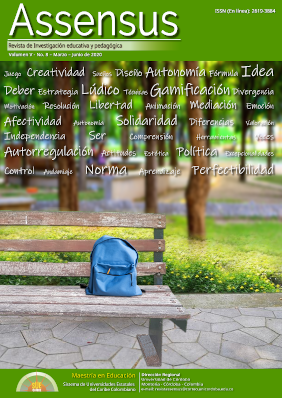The written press and its contribution to critical reading and argued writing
La prensa escrita y su contribución a la lectura crítica y la escritura argumentada
The Assensus journal has a Creative Commons license. The citation, use and partial or total reproduction of the contents is authorized by citing sources. For more information, see https://creativecommons.org/licenses/by-sa/4.0/deed.en
Show authors biography
This article shows the results of a research project carried out in the educational institution German Gomez Peláez, in Puerto Libertador - Cordoba, with the objective of establishing the contribution of the work with the written press, from a communicative approach to language, in the development of critical reading and argumentative writing of 10th grade students. Theoretically it is based on the communicative and discursive conception of language, and it is based on the postulates of authors such as Maria Cristina Martinez, Daniel Casanny, Carlos Lomas, among others. An interpretative qualitative methodology was adopted and comprised three phases: exploratory, with the objective of analyzing the language approach and the didactic strategies applied by teachers in the teaching of reading and writing, through the application of a semi-structured interview to 4 language teachers; Execution, which included the design and application of a system of didactic sequences, from the communicative perspective of language, for the development of critical reading and argumentative writing of 30 10th grade students; Evaluation, discussion groups were held in order to evaluate the results of the application of the system of didactic sequences taking into account the perceptions of students about their practices of comprehension and written production. The results of the application of didactic sequences, allowed the students to identify the communicative intentions and purposes of opinion texts, their statements and ideological inclinations, and the intentions of manipulation and management of power. In the same way, there were advances in his ability to write opinion columns taking into account the micro, macro and superstructural elements of the texts, as well as argumentation strategies.
Article visits 832 | PDF visits
Downloads
- Atorresi, Ana y Colaboradores (2012). Aportes para la enseñanza de la lectura. Segundo estudio regional comparativo y explicativo SERCE. Bogotá: Kimpres.
- Blasco, J., Pérez, J. (2007). Metodologías de investigación en las ciencias de la actividad física y el deporte: ampliando horizontes. Universidad de Alicante: Editorial Club Universitario, p. 374.
- Calsamiglia, H., y Tusón, A. (1999). Las cosas del decir. Ariel Letras
- Cassany, D. (2003). Aproximaciones a la lectura crítica: teoría, ejemplos y reflexiones. Barcelona: Revista de Investigación e Innovación Educativa, (32), 113-132.
- Díaz-Barriga, A. (2013). Guía para la elaboración de una secuencia didáctica. México: Universidad Nacional Autónoma de México.
- Dolz, J. y Schneuwly, B. (1998). Pour un enseignement de l’oral. Paris, ESF.
- Dolz, J.; Noverraz, M.; Schneuwly, B. (2001). Séquences didactiques pour l’oral et pour l’écrit: Notes méthodologiques. Bruxelles, De Boeck, vol. II, 3e/4e. En: Las secuencias didácticas de lengua: una encrucijada entre teoría y metodología. https://www.researchgate.net/publication/303357232.
- Litwin, E. (1997). Las configuraciones fidácticas. Buenos Aires: Paidós.
- Lomas, C. (2018) Enseñar Lengua y Literatura para aprender a comunicarse. La educación Lingüística y literaria en secundaria.
- Martínez, M. (2001). Catedra UNESCO para la lectura y la escritura en América Latina. Cali: Universidad del Valle.
- Ministerio de Educación Nacional (1998). Lineamientos Curriculares de Lengua Castellana. Bogotá.
- Ministerio de Educación Nacional. MEN. (2012). Programa Todos a Aprender -PTA- en Colombia.
- Van Dijk, T. (2003). Racismo y discurso de las élites. Barcelona: Gedisa.
- Vargas, I. (2012). La entrevista en la investigación cualitativa: nuevas tendencias y retos. Centro de Investigación y Docencia en Educación, Universidad Nacional, Costa Rica.



